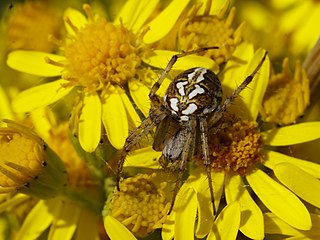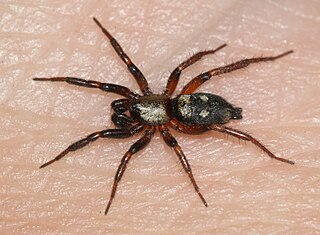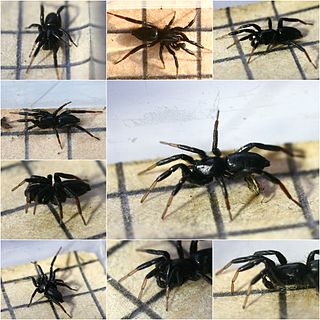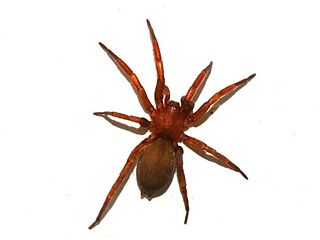
Tegenaria is a genus of fast-running funnel weavers that occupy much of the Northern Hemisphere except for Japan and Indonesia. It was first described by Pierre André Latreille in 1804, though many of its species have been moved elsewhere. The majority of these were moved to Eratigena, including the giant house spider and the hobo spider.

Xysticus is a genus of ground crab spiders described by C. L. Koch in 1835, belonging to the order Araneae, family Thomisidae. The genus name is derived from the Ancient Greek root xyst, meaning "scraped, scraper".

Drassodes is a genus of ground spiders that was first described by Niklas Westring in 1851. They are brown, gray, and red spiders that live under rocks or bark in mostly dry habitats, and are generally 3.8 to 11.6 millimetres long, but can reach up to 20 millimetres (0.79 in) in length.

Ozyptila is a genus of crab spiders that was first described by Eugène Louis Simon in 1864. It has been misspelled as "Oxyptila" in multiple accounts.

Lycosa is a genus of wolf spiders distributed throughout most of the world. Sometimes called the "true tarantula", though not closely related to the spiders most commonly called tarantulas today, Lycosa spp. can be distinguished from common wolf spiders by their relatively large size. This genus includes the European Lycosa tarantula, which was once associated with tarantism, a dubious affliction whose symptoms included shaking, cold sweats, and a high fever, asserted to be curable only by the traditional tarantella dance. No scientific substantiation of that myth is known; the venom of Lycosa spiders is generally not harmful.

Peucetia is a genus of lynx spiders that is found worldwide.

Neoscona, known as spotted orb-weavers and barn spiders, is a genus of orb-weaver spiders (Araneidae) first described by Eugène Simon in 1895 to separate these from other araneids in the now obsolete genus Epeira. The name Neoscona was derived from the Greek νέω, meaning "spin", and σχοῐνος, meaning "reed" They have a mostly pantropical distribution and one species, Neoscona adianta, has a palearctic distribution. As of April 2019 there are eight species that can be found in the United States and Canada:

Pardosa is a large genus of wolf spiders, with more than 500 described species that are found in all regions of the world.

Callilepis is a genus of ground spiders first described by Niklas Westring in 1874. Some are found from Mexico to Canada, others from Europe to India. They are most commonly found in dry areas, sandy roads and beaches.

Zelotes is a genus of ground spiders that was first described by J. Gistel in 1848.

Gnaphosa is a genus of ground spiders that was first described by Pierre André Latreille in 1804. They all have a serrated keel on the retromargin of each chelicera.

Scotophaeus is a genus of ground spiders that was first described by Eugène Simon in 1893.

Drassyllus is a genus of ground spiders that was first described by R. V. Chamberlin in 1922.

Haplodrassus is a genus of ground spiders that was first described by R. V. Chamberlin in 1922. They range from 3 to 10 millimetres. H. signifer is the most widespread species, found across North America except for Alaska and northern Canada.
Poecilochroa is a genus of ground spiders that was first described by Niklas Westring in 1874.
Sosticus is a genus of ground spiders that was first described by R. V. Chamberlin in 1922.
Civizelotes is a genus of ground spiders that was first described by A. Senglet in 2012.













